JEEP CHEROKEE 2014 KL / 5.G Owners Manual
Manufacturer: JEEP, Model Year: 2014, Model line: CHEROKEE, Model: JEEP CHEROKEE 2014 KL / 5.GPages: 690, PDF Size: 4.74 MB
Page 541 of 690
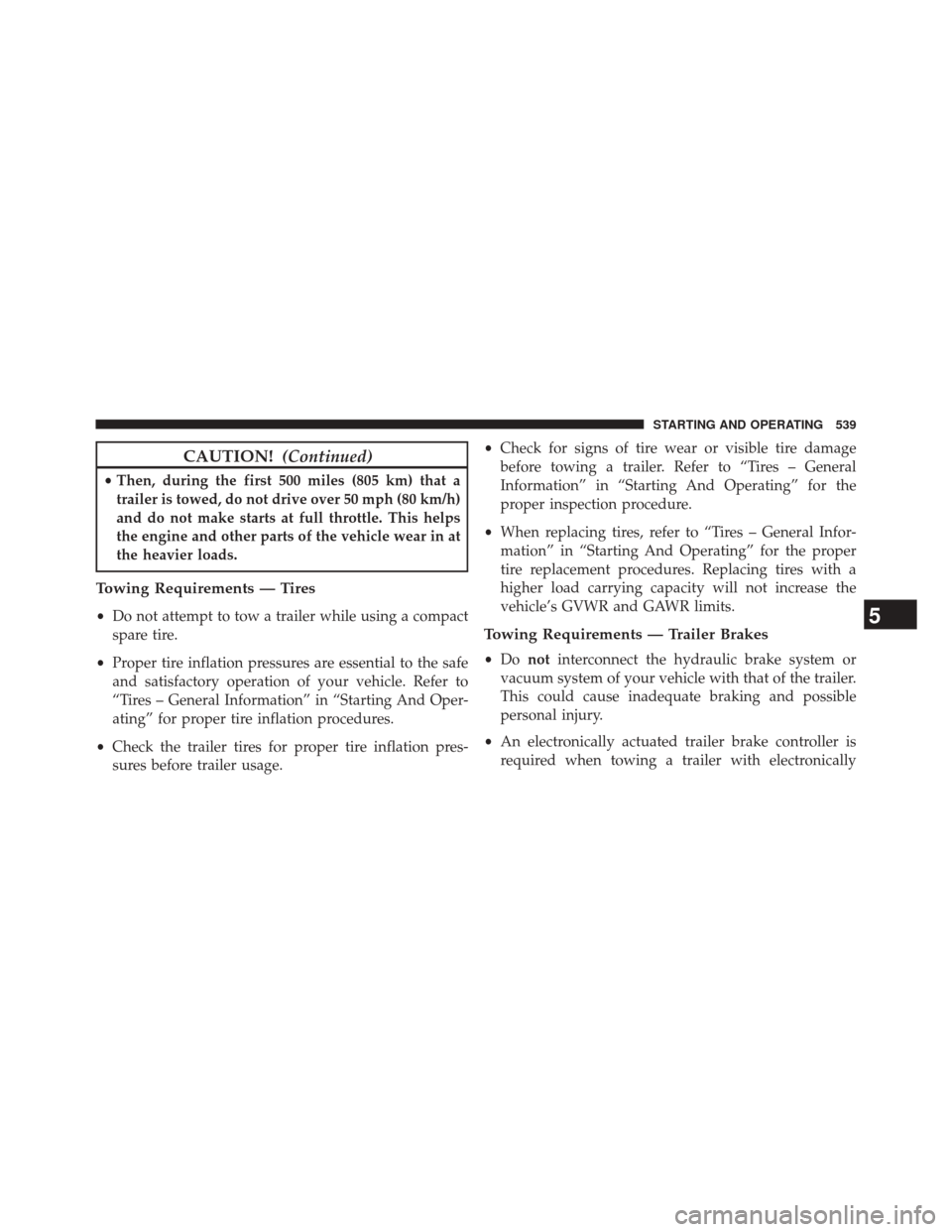
CAUTION!(Continued)
•Then, during the first 500 miles (805 km) that a
trailer is towed, do not drive over 50 mph (80 km/h)
and do not make starts at full throttle. This helps
the engine and other parts of the vehicle wear in at
the heavier loads.
Towing Requirements — Tires
• Do not attempt to tow a trailer while using a compact
spare tire.
• Proper tire inflation pressures are essential to the safe
and satisfactory operation of your vehicle. Refer to
“Tires – General Information” in “Starting And Oper-
ating” for proper tire inflation procedures.
• Check the trailer tires for proper tire inflation pres-
sures before trailer usage. •
Check for signs of tire wear or visible tire damage
before towing a trailer. Refer to “Tires – General
Information” in “Starting And Operating” for the
proper inspection procedure.
• When replacing tires, refer to “Tires – General Infor-
mation” in “Starting And Operating” for the proper
tire replacement procedures. Replacing tires with a
higher load carrying capacity will not increase the
vehicle’s GVWR and GAWR limits.
Towing Requirements — Trailer Brakes
• Do not interconnect the hydraulic brake system or
vacuum system of your vehicle with that of the trailer.
This could cause inadequate braking and possible
personal injury.
• An electronically actuated trailer brake controller is
required when towing a trailer with electronically
5
STARTING AND OPERATING 539
Page 542 of 690
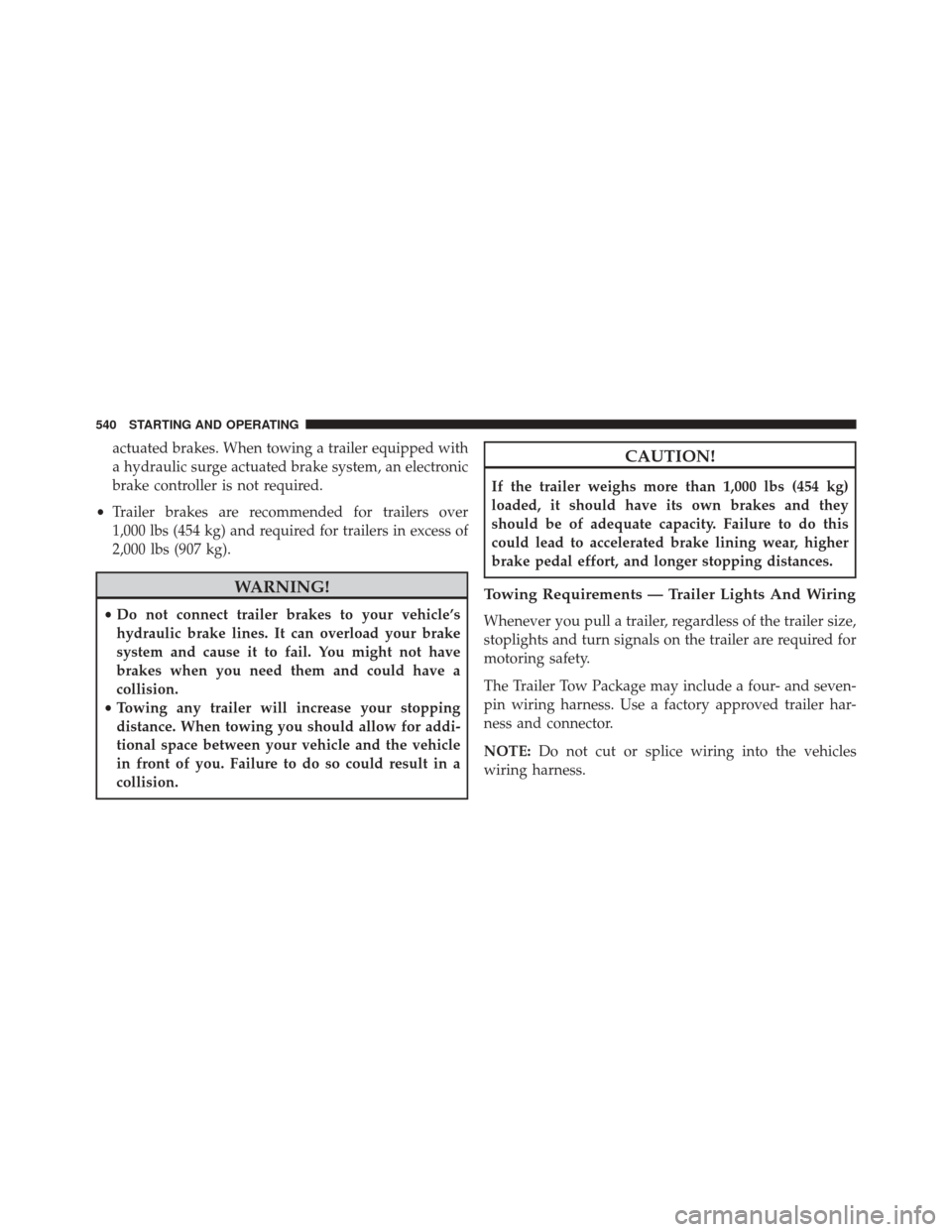
actuated brakes. When towing a trailer equipped with
a hydraulic surge actuated brake system, an electronic
brake controller is not required.
• Trailer brakes are recommended for trailers over
1,000 lbs (454 kg) and required for trailers in excess of
2,000 lbs (907 kg).
WARNING!
• Do not connect trailer brakes to your vehicle’s
hydraulic brake lines. It can overload your brake
system and cause it to fail. You might not have
brakes when you need them and could have a
collision.
• Towing any trailer will increase your stopping
distance. When towing you should allow for addi-
tional space between your vehicle and the vehicle
in front of you. Failure to do so could result in a
collision.
CAUTION!
If the trailer weighs more than 1,000 lbs (454 kg)
loaded, it should have its own brakes and they
should be of adequate capacity. Failure to do this
could lead to accelerated brake lining wear, higher
brake pedal effort, and longer stopping distances.
Towing Requirements — Trailer Lights And Wiring
Whenever you pull a trailer, regardless of the trailer size,
stoplights and turn signals on the trailer are required for
motoring safety.
The Trailer Tow Package may include a four- and seven-
pin wiring harness. Use a factory approved trailer har-
ness and connector.
NOTE: Do not cut or splice wiring into the vehicles
wiring harness.
540 STARTING AND OPERATING
Page 543 of 690
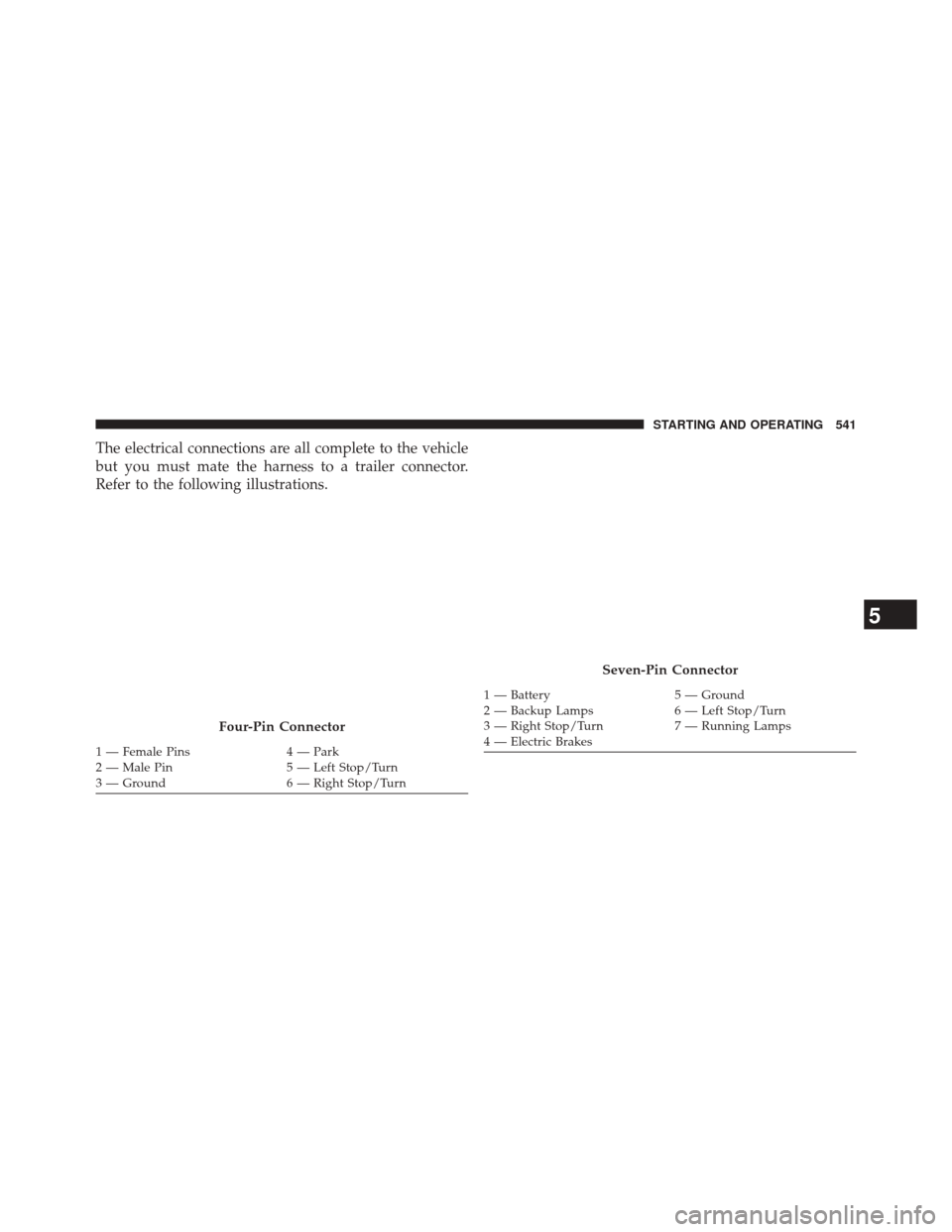
The electrical connections are all complete to the vehicle
but you must mate the harness to a trailer connector.
Refer to the following illustrations.
Four-Pin Connector
1 — Female Pins4 — Park
2 — Male Pin 5 — Left Stop/Turn
3 — Ground 6 — Right Stop/Turn
Seven-Pin Connector
1 — Battery5 — Ground
2 — Backup Lamps 6 — Left Stop/Turn
3 — Right Stop/Turn 7 — Running Lamps
4 — Electric Brakes
5
STARTING AND OPERATING 541
Page 544 of 690
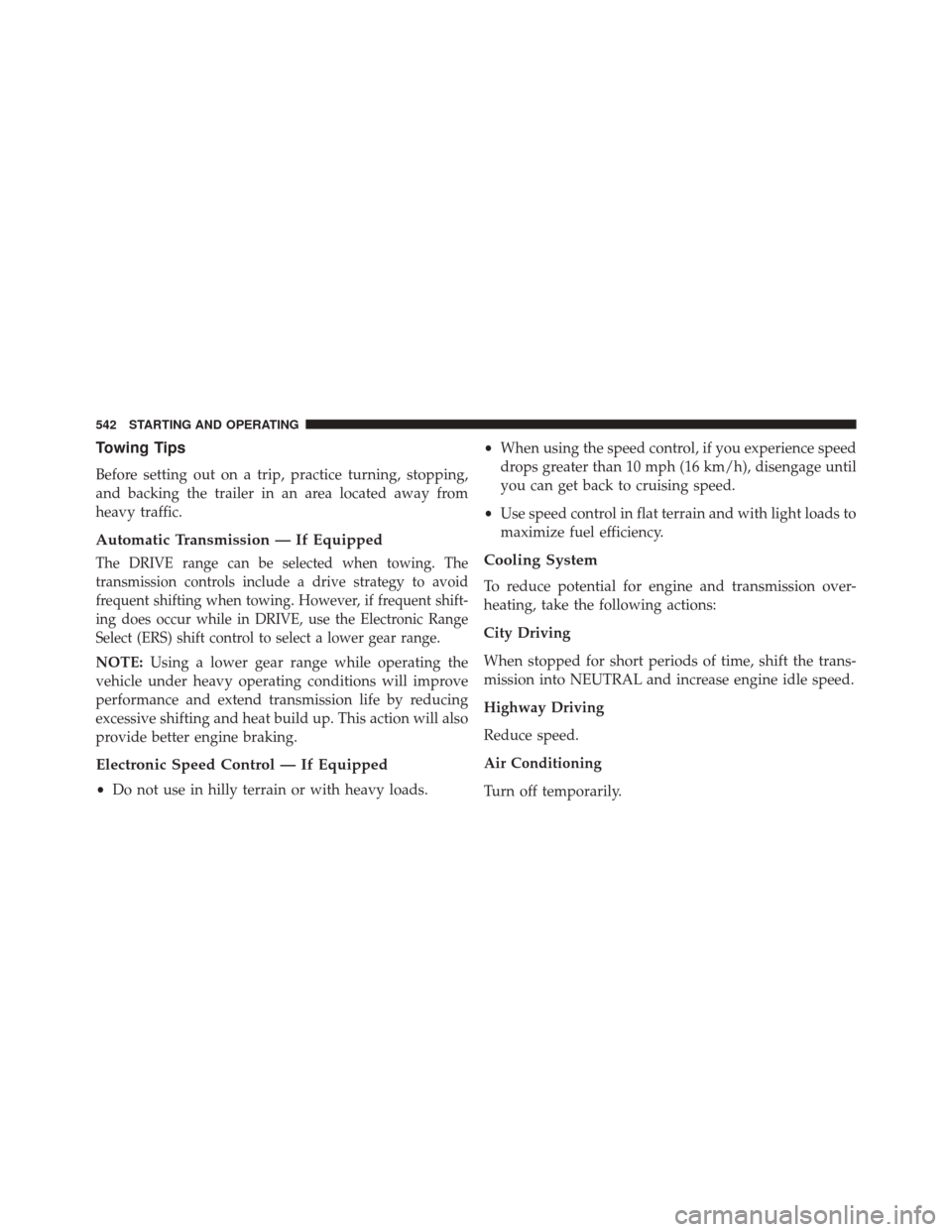
Towing Tips
Before setting out on a trip, practice turning, stopping,
and backing the trailer in an area located away from
heavy traffic.
Automatic Transmission — If Equipped
The DRIVE range can be selected when towing. The
transmission controls include a drive strategy to avoid
frequent shifting when towing. However, if frequent shift-
ing does occur while in DRIVE, use the Electronic Range
Select (ERS) shift control to select a lower gear range.
NOTE:Using a lower gear range while operating the
vehicle under heavy operating conditions will improve
performance and extend transmission life by reducing
excessive shifting and heat build up. This action will also
provide better engine braking.
Electronic Speed Control — If Equipped
• Do not use in hilly terrain or with heavy loads. •
When using the speed control, if you experience speed
drops greater than 10 mph (16 km/h), disengage until
you can get back to cruising speed.
• Use speed control in flat terrain and with light loads to
maximize fuel efficiency.
Cooling System
To reduce potential for engine and transmission over-
heating, take the following actions:
City Driving
When stopped for short periods of time, shift the trans-
mission into NEUTRAL and increase engine idle speed.
Highway Driving
Reduce speed.
Air Conditioning
Turn off temporarily.
542 STARTING AND OPERATING
Page 545 of 690
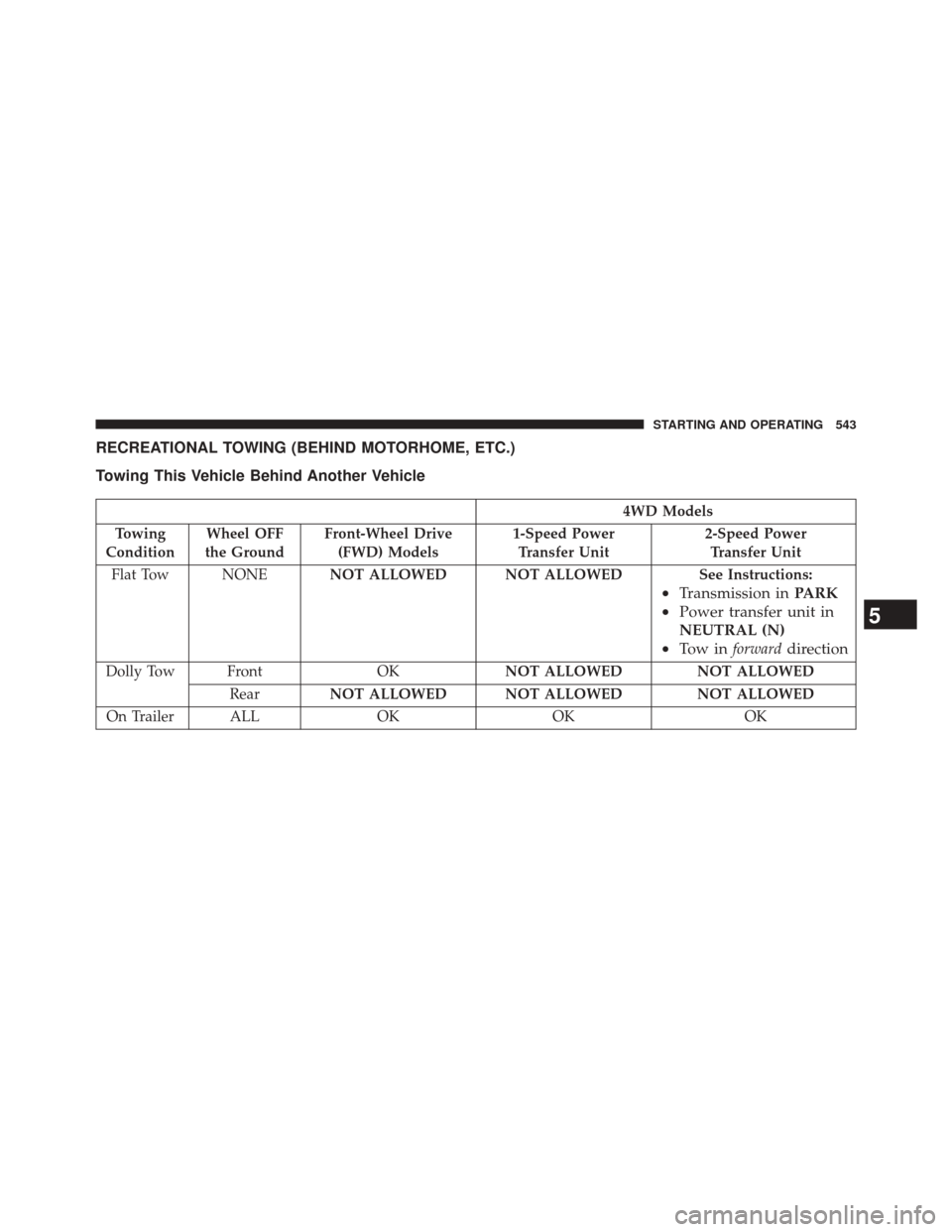
RECREATIONAL TOWING (BEHIND MOTORHOME, ETC.)
Towing This Vehicle Behind Another Vehicle
4WD Models
Towing
Condition Wheel OFF
the Ground Front-Wheel Drive
(FWD) Models 1-Speed Power
Transfer Unit 2-Speed Power
Transfer Unit
Flat Tow NONE NOT ALLOWED NOT ALLOWED See Instructions:
•Transmission in PARK
• Power transfer unit in
NEUTRAL (N)
• To w i n forward direction
Dolly Tow Front OKNOT ALLOWED NOT ALLOWED
Rear NOT ALLOWED NOT ALLOWED NOT ALLOWED
On Trailer ALL OKOK OK
5
STARTING AND OPERATING 543
Page 546 of 690
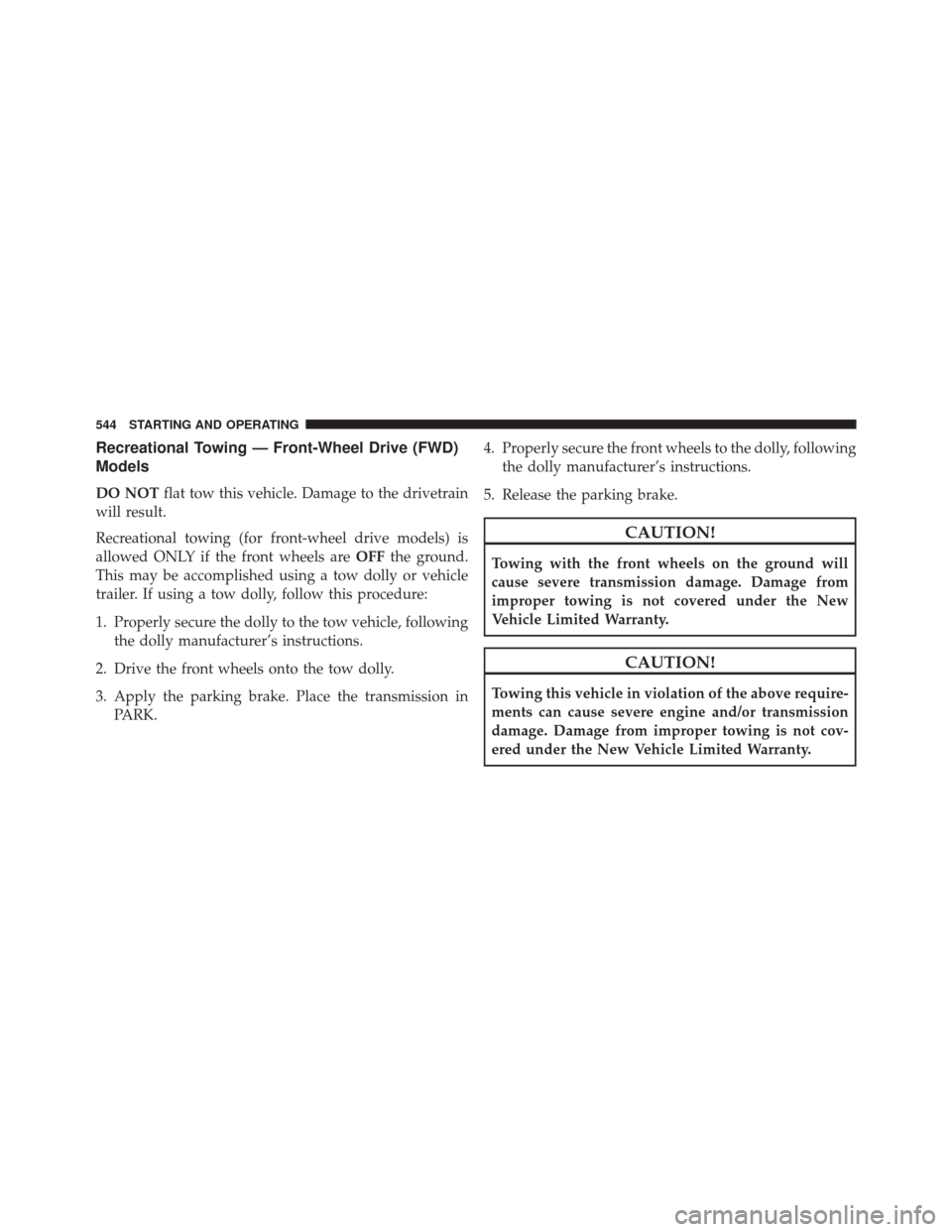
Recreational Towing — Front-Wheel Drive (FWD)
Models
DO NOTflat tow this vehicle. Damage to the drivetrain
will result.
Recreational towing (for front-wheel drive models) is
allowed ONLY if the front wheels are OFFthe ground.
This may be accomplished using a tow dolly or vehicle
trailer. If using a tow dolly, follow this procedure:
1. Properly secure the dolly to the tow vehicle, following the dolly manufacturer’s instructions.
2. Drive the front wheels onto the tow dolly.
3. Apply the parking brake. Place the transmission in PARK. 4. Properly secure the front wheels to the dolly, following
the dolly manufacturer’s instructions.
5. Release the parking brake.
CAUTION!
Towing with the front wheels on the ground will
cause severe transmission damage. Damage from
improper towing is not covered under the New
Vehicle Limited Warranty.
CAUTION!
Towing this vehicle in violation of the above require-
ments can cause severe engine and/or transmission
damage. Damage from improper towing is not cov-
ered under the New Vehicle Limited Warranty.
544 STARTING AND OPERATING
Page 547 of 690
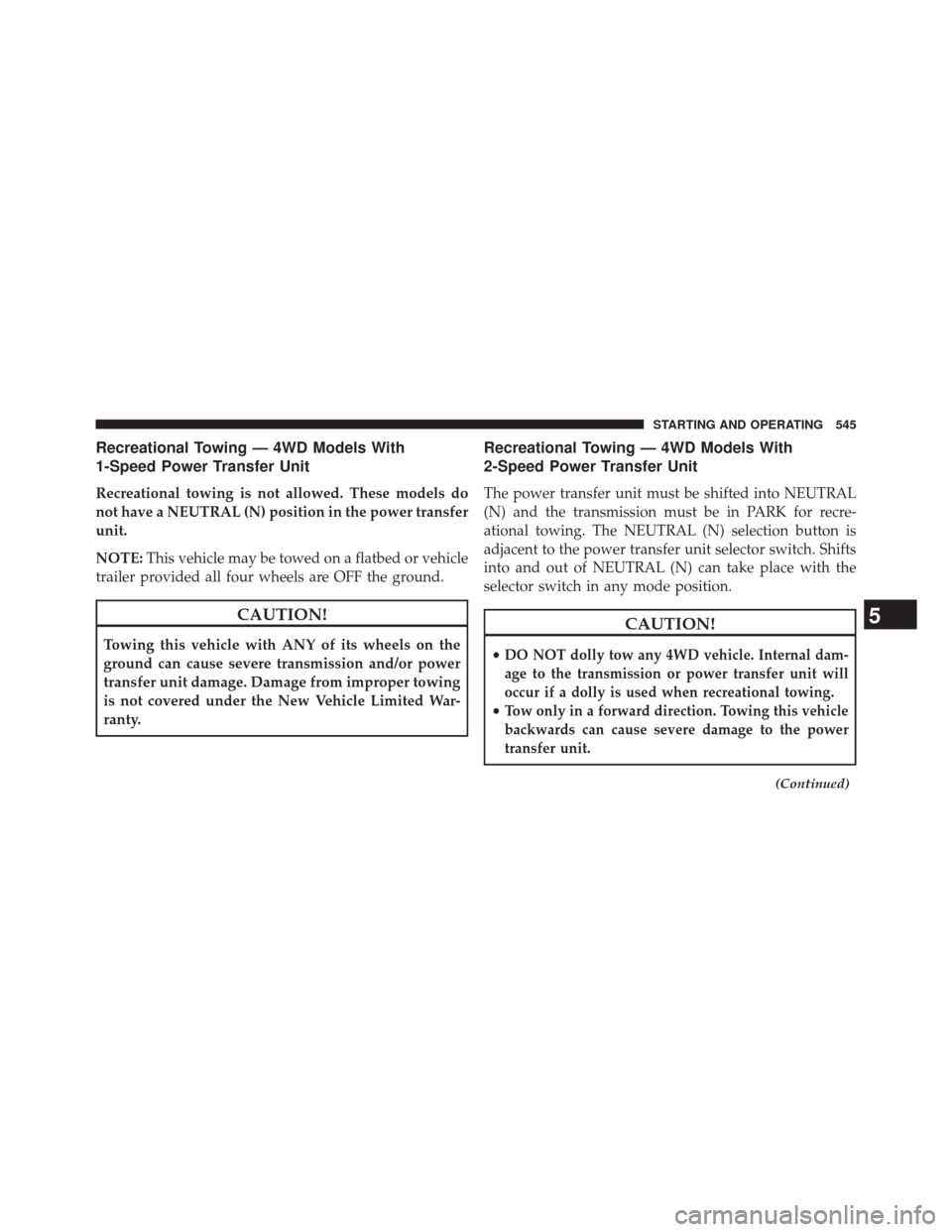
Recreational Towing — 4WD Models With
1-Speed Power Transfer Unit
Recreational towing is not allowed. These models do
not have a NEUTRAL (N) position in the power transfer
unit.
NOTE:This vehicle may be towed on a flatbed or vehicle
trailer provided all four wheels are OFF the ground.
CAUTION!
Towing this vehicle with ANY of its wheels on the
ground can cause severe transmission and/or power
transfer unit damage. Damage from improper towing
is not covered under the New Vehicle Limited War-
ranty.
Recreational Towing — 4WD Models With
2-Speed Power Transfer Unit
The power transfer unit must be shifted into NEUTRAL
(N) and the transmission must be in PARK for recre-
ational towing. The NEUTRAL (N) selection button is
adjacent to the power transfer unit selector switch. Shifts
into and out of NEUTRAL (N) can take place with the
selector switch in any mode position.
CAUTION!
•DO NOT dolly tow any 4WD vehicle. Internal dam-
age to the transmission or power transfer unit will
occur if a dolly is used when recreational towing.
•Tow only in a forward direction. Towing this vehicle
backwards can cause severe damage to the power
transfer unit.
(Continued)
5
STARTING AND OPERATING 545
Page 548 of 690
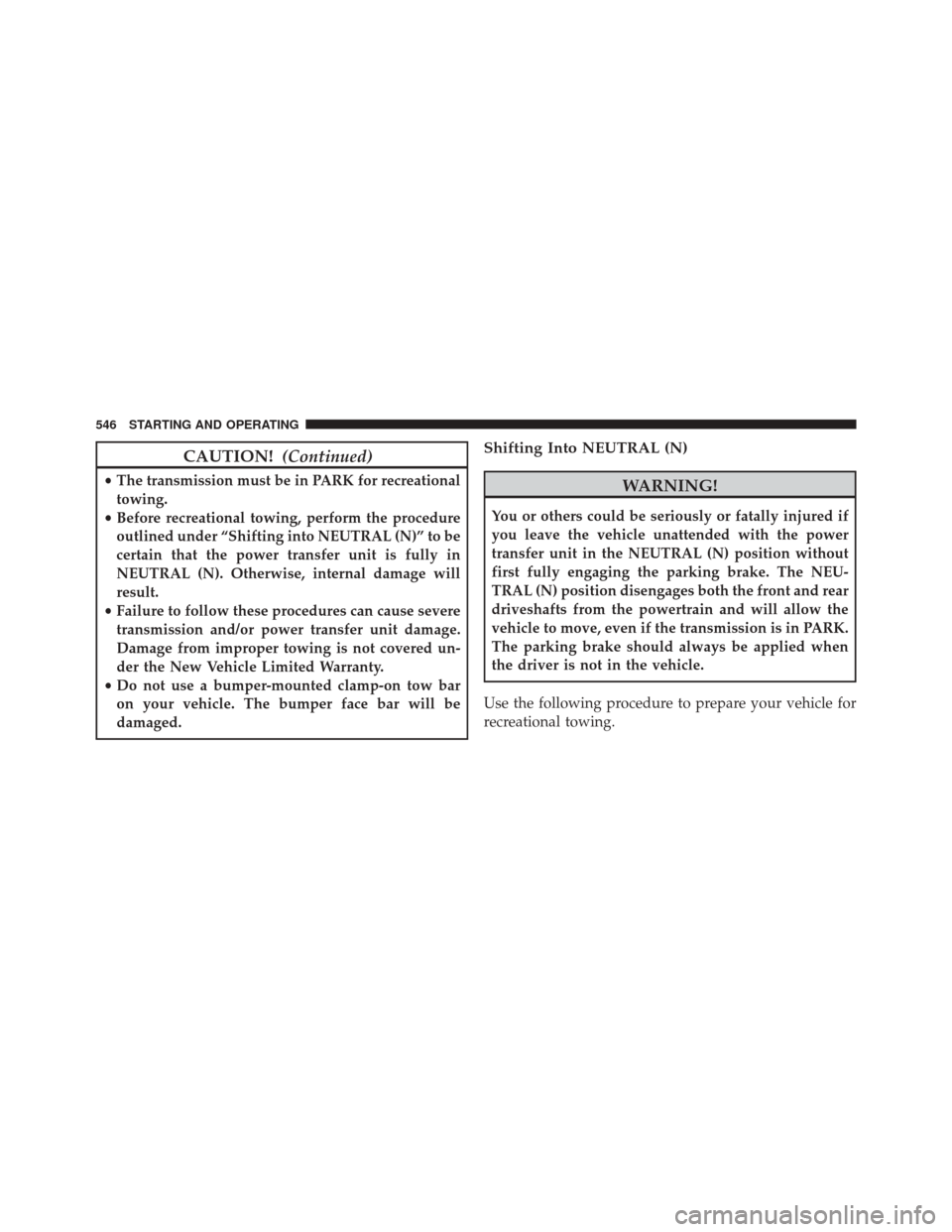
CAUTION!(Continued)
•The transmission must be in PARK for recreational
towing.
• Before recreational towing, perform the procedure
outlined under “Shifting into NEUTRAL (N)” to be
certain that the power transfer unit is fully in
NEUTRAL (N). Otherwise, internal damage will
result.
• Failure to follow these procedures can cause severe
transmission and/or power transfer unit damage.
Damage from improper towing is not covered un-
der the New Vehicle Limited Warranty.
• Do not use a bumper-mounted clamp-on tow bar
on your vehicle. The bumper face bar will be
damaged.
Shifting Into NEUTRAL (N)
WARNING!
You or others could be seriously or fatally injured if
you leave the vehicle unattended with the power
transfer unit in the NEUTRAL (N) position without
first fully engaging the parking brake. The NEU-
TRAL (N) position disengages both the front and rear
driveshafts from the powertrain and will allow the
vehicle to move, even if the transmission is in PARK.
The parking brake should always be applied when
the driver is not in the vehicle.
Use the following procedure to prepare your vehicle for
recreational towing.
546 STARTING AND OPERATING
Page 549 of 690
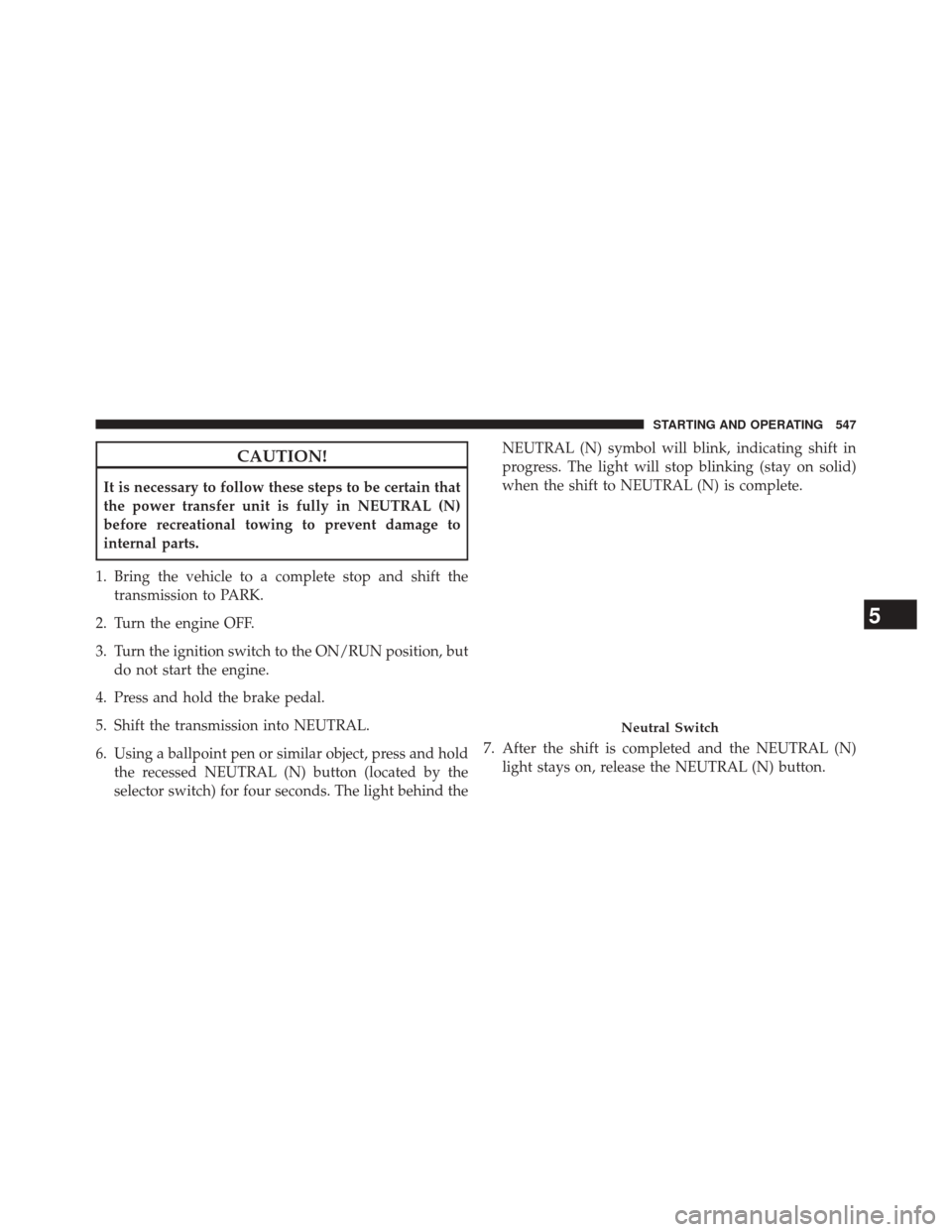
CAUTION!
It is necessary to follow these steps to be certain that
the power transfer unit is fully in NEUTRAL (N)
before recreational towing to prevent damage to
internal parts.
1. Bring the vehicle to a complete stop and shift the transmission to PARK.
2. Turn the engine OFF.
3. Turn the ignition switch to the ON/RUN position, but do not start the engine.
4. Press and hold the brake pedal.
5. Shift the transmission into NEUTRAL.
6. Using a ballpoint pen or similar object, press and hold the recessed NEUTRAL (N) button (located by the
selector switch) for four seconds. The light behind the NEUTRAL (N) symbol will blink, indicating shift in
progress. The light will stop blinking (stay on solid)
when the shift to NEUTRAL (N) is complete.
7. After the shift is completed and the NEUTRAL (N) light stays on, release the NEUTRAL (N) button.
Neutral Switch
5
STARTING AND OPERATING 547
Page 550 of 690
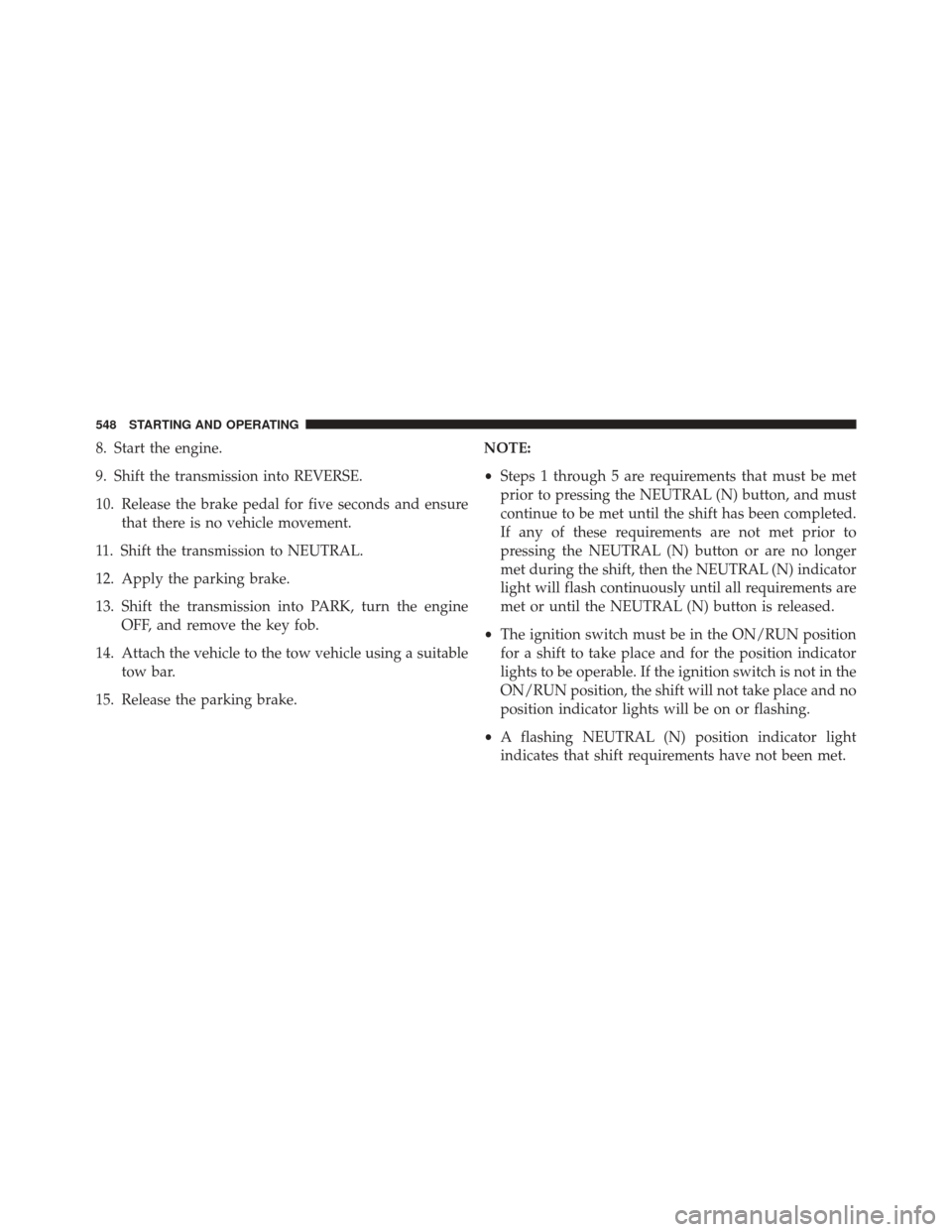
8. Start the engine.
9. Shift the transmission into REVERSE.
10. Release the brake pedal for five seconds and ensurethat there is no vehicle movement.
11. Shift the transmission to NEUTRAL.
12. Apply the parking brake.
13. Shift the transmission into PARK, turn the engine OFF, and remove the key fob.
14. Attach the vehicle to the tow vehicle using a suitable tow bar.
15. Release the parking brake. NOTE:
•
Steps 1 through 5 are requirements that must be met
prior to pressing the NEUTRAL (N) button, and must
continue to be met until the shift has been completed.
If any of these requirements are not met prior to
pressing the NEUTRAL (N) button or are no longer
met during the shift, then the NEUTRAL (N) indicator
light will flash continuously until all requirements are
met or until the NEUTRAL (N) button is released.
• The ignition switch must be in the ON/RUN position
for a shift to take place and for the position indicator
lights to be operable. If the ignition switch is not in the
ON/RUN position, the shift will not take place and no
position indicator lights will be on or flashing.
• A flashing NEUTRAL (N) position indicator light
indicates that shift requirements have not been met.
548 STARTING AND OPERATING